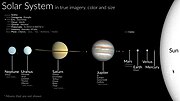 | This is a list of known objects which occupy, have occupied, or are planned to occupy any of the five Lagrange points of two-body systems in space. L1... 37 KB (2,503 words) - 19:19, 24 February 2024 |
 | Trojan (celestial body) (redirect from Trojan points) Lissajous orbit List of objects at Lagrange points Tadpole orbit Robutel, Philippe; Souchay, Jean (2010), "An introduction to the dynamics of trojan asteroids"... 14 KB (1,446 words) - 01:38, 24 January 2024 |
astronauts are listed), objects in the Sun–Earth Lagrange points or objects that are escaping from the Solar System. The Federal government of the United... 8 KB (831 words) - 01:15, 31 December 2023 |
 | Lagrange at the Mathematics Genealogy Project The Founders of Classical Mechanics: Joseph Louis Lagrange The Lagrange Points Derivation of Lagrange's... 47 KB (6,141 words) - 16:46, 20 March 2024 |
 | comets and near-Earth objects. Many trans-Neptunian objects (TNOs) have been discovered; in many cases their positions in this list are approximate, as... 250 KB (10,637 words) - 17:18, 19 April 2024 |
 | other astronomical objects. For hypothetical astronomical objects in the Solar System, see: List of hypothetical Solar System objects For hypothetical stars... 6 KB (312 words) - 09:35, 1 May 2024 |
 | Lagrangian mechanics (redirect from Lagrange's equations) Italian-French mathematician and astronomer Joseph-Louis Lagrange in his presentation to the Turin Academy of Science in 1760 culminating in his 1788 grand opus... 90 KB (14,207 words) - 17:19, 20 April 2024 |
 | Lunar orbit (category Orbit of the Moon) together with one of the Earth-Moon Lagrange points, as employed by lunar relay satellites to the far side of the Moon, the first of such kind being the... 16 KB (1,730 words) - 18:59, 18 April 2024 |
 | Deep Space Climate Observatory (category Artificial satellites at Earth-Sun Lagrange points) February 2015, and reached L1 on 8 June 2015, joining the list of objects orbiting at Lagrange points. NOAA operates DSCOVR from its Satellite and Product... 33 KB (3,201 words) - 01:29, 25 December 2023 |
 | closest to Jupiter's orbit (i.e. at their aphelion) just when either one of Jupiter's L5, L4 or L3 Lagrange points arrives there. On their next orbit... 11 KB (1,294 words) - 00:54, 3 December 2023 |
stable because of its interactions with two Lagrange points (L1 and L2) of the planet–moon system. In more general terms, an object of negligible mass... 10 KB (960 words) - 08:11, 8 February 2024 |
property List of triangle topics Combinatorics concerns the study of discrete (and usually finite) objects. Aspects include "counting" the objects satisfying... 21 KB (2,591 words) - 15:29, 7 January 2024 |
 | Apsis (section Lines of apsides) that joins the nearest and farthest points across an orbit; it also refers simply to the extreme range of an object orbiting a host body (see top figure;... 42 KB (3,898 words) - 23:55, 26 April 2024 |
 | Hill sphere (category CS1 maint: multiple names: authors list) needed] at one of the nearby Lagrange points, forming a cone-like point there.[clarification needed][not verified in body] At the opposite side of the less... 26 KB (2,934 words) - 21:11, 2 May 2024 |
 | Orbit (redirect from Orbits of planets) of an artificial satellite around an object or position in space such as a planet, moon, asteroid, or Lagrange point. Normally, orbit refers to a regularly... 57 KB (8,169 words) - 16:56, 16 April 2024 |
Orbital elements (redirect from Elements of an orbit) perturbations by other objects and the effects of general relativity. A Kepler orbit is an idealized, mathematical approximation of the orbit at a particular time... 23 KB (2,939 words) - 23:23, 27 April 2024 |
implement one of the SGP models to correctly compute the state at a time of interest. TLEs can describe the trajectories only of Earth-orbiting objects. TLEs... 15 KB (1,737 words) - 22:19, 15 March 2024 |
 | Solar System (redirect from Astronomy of the solar system) those objects closer to the Sun, which are more affected by heat and light pressure, are composed of elements with high melting points. Objects farther... 207 KB (20,853 words) - 05:52, 4 May 2024 |
 | James Webb Space Telescope (category Artificial satellites at Earth-Sun Lagrange points) French Guiana. In January 2022 it arrived at its destination, a solar orbit near the Sun–Earth L2 Lagrange point, about 1.5 million kilometers (930,000 mi)... 210 KB (19,485 words) - 20:25, 23 April 2024 |
 | Earth's orbit (redirect from Orbit of the Earth) (such as Laplace, Lagrange, Gauss, Poincaré, Kolmogorov, Vladimir Arnold, and Jürgen Moser) have searched for evidence for the stability of the planetary... 17 KB (1,834 words) - 05:28, 17 March 2024 |
 | Astronomical coordinate systems (redirect from Longitude of vernal equinox) positions of celestial objects (satellites, planets, stars, galaxies, etc.) relative to a given reference frame, based on physical reference points available... 28 KB (3,948 words) - 03:55, 7 April 2024 |
list excludes astronauts of Indian origin. List of Asian astronauts List of Indian mathematicians List of Indian scientists "Cosmonaut Biography: Rakesh... 3 KB (99 words) - 13:03, 7 April 2024 |
journal') is a book with tables that gives the trajectory of naturally occurring astronomical objects as well as artificial satellites in the sky, i.e., the... 16 KB (1,697 words) - 05:46, 4 April 2024 |
 | Aditya-L1 (category Satellites of India) Aditya-L1 (/aːd̪it̪jə/) (from Sanskrit: Aditya, "Sun" and L1, "Lagrange point 1") is a coronagraphy spacecraft for studying the solar atmosphere, designed... 40 KB (3,517 words) - 16:44, 22 April 2024 |





